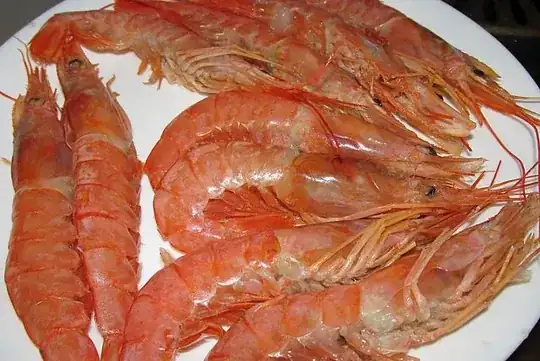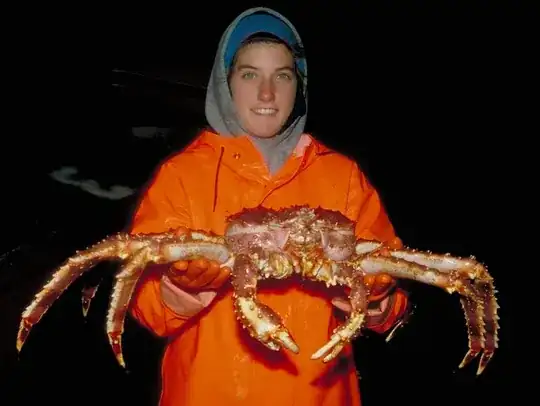Ok, the short guide to crustaceans seafood in Germany.
Unfortunately the usage of Krabben (crab/shrimp), Krebs (crab), Garnelen (shrimp) and so in German reduce biologists to tears. It is ambigous and often wrong from the view of biology.
Also the english equivalents of crab, crayfish, shrimps or lobster are not exactly 1:1 translateable because of different meanings. In German, e.g. Krebs is both used for zodiac sign, the illness and a specific kind of crustaceans.
Nordsee-Garnele (even officially Nordsee-Krabbe), Porren, Granat, Krevetten (Crangon crangon).
This is what you get normally if you order "Krabben" or "Garnelen" on a pizza. It is widely used for literally everything as you can see in the German wikipedia page.).
 Lou Stejskal, CC BY-SA 2.0 2016-08-17
Lou Stejskal, CC BY-SA 2.0 2016-08-17
 Public Domain, 2018-03-18
Public Domain, 2018-03-18
Gambas, Riesengarnele (mostly Litopenaeus vannamei)
Germans use the Spanish word "Gambas" normally to describe big shrimps aka king prawns. It is very unspecified, only length counts, they should be at least 6cm long.
Types:
White-Tiger Garnele (Litopenaeus vannamei), in English whiteleg shrimp or king prawn.
 Xufanc, CC BY-SA 3.0, 2011-11-30
Xufanc, CC BY-SA 3.0, 2011-11-30
Eismeer-Garnele, Grönlandkrabbe (Pandalus borealis), in English northern prawn.
 Alaska Fischeries, Public Domain, 2011-09-14
Alaska Fischeries, Public Domain, 2011-09-14
Argentinische Rotgarnele (Pleoticus muelleri, auch Langostinos Patagonicos), in English argentine red shrimp.
 Assianir, CC BY-SA 4.0, 2015-06-02
Assianir, CC BY-SA 4.0, 2015-06-02
Black-Tiger Garnele, Black-Tiger Shrimp (Penaeus monodon)
An alternative to the Nordsee-Garnele it is marketed as Black-Tiger Garnele/Shrimp (yes, the English is unchanged in Germany), it is also offered on pizza. In English giant tiger prawn or Asian-tiger shrimp.
 GFDL, 2008-11-10
GFDL, 2008-11-10
Scampi, Kaisergranat, Hummerkrabbe (Nephrops norvegicus)
They are both known as "Scampi" or "Kaisergranat" (rare) in Germany.
Allegedly extremely delicious, they are shrimps which are found in luxury restaurants. There have been several incidences where restaurants in Hamburg have served cheaper shrimps despite being explicitly ordered Scampi. In English they are known as Scampi or Norway Lobster
 Public domain, 2010-06-07
Public domain, 2010-06-07
Taschenkrebs, Knieper (Cancer pagurus)
Despite being called a Krebs, it is actually a crab. This is the typical real crab fished in the North Sea, almost exclusively used for this purpose; the people on Heligoland call them "Knieper" (Pincher). It's very delicious and in Heligoland it is in fact used for pizza, the so-called "Knieper pizza" In English it is the brown crab.
 Hans Hillewaert, CC BY-SA 4.0, 2006-03-06
Hans Hillewaert, CC BY-SA 4.0, 2006-03-06
Krebs, Flusskrebs (river crayfish), Edelkrebs (Astacus astacus)
This is what Germans know as archetypical Krebs (crab). It you want Krebs, this is normally what you get (Because this crab is getting rare, another Astacus species, the Galizischer Sumpfkrebs (Astacus leptodactylus) from Eastern Europe is quite often used).
 Dragon187, CC BY-SA 3.0, 2011-07-01
Dragon187, CC BY-SA 3.0, 2011-07-01
Hummer, Europäischer Hummer (Homarus gammarus)
Like the Krebs, this is the archetype of a German Hummer (lobster). They are caught near Heligoland, but served everywhere in Germany. In English common lobster
 Bart Braun, Public Domain, 2017-10-22
Bart Braun, Public Domain, 2017-10-22
Königskrabbe (king's crab), Kamtschatkakrabbe, Monsterkrabbe(Paralithodes camtschaticus)
Sure it is possible in German to get it wrong the other way round: The Königskrabbe is in reality a Krebs. While not native in vicinity of Germany (it is bred in the Barents Sea in northern Scandinavia), it is still widely used in restaurants here. In English it is the red king crab.
 National Oceanic and Atmospheric Administration, Public Domain
National Oceanic and Atmospheric Administration, Public Domain
Languste, Europäische/Gewöhnliche Languste (Palinurus elephas)
The archetypical Languste for Germans, it is mostly caught in the Mediterranean Sea. In English spiny lobster or red lobster.
 Georges Jansoone, CC BY-SA 3.0, 2009-05-09
Georges Jansoone, CC BY-SA 3.0, 2009-05-09











